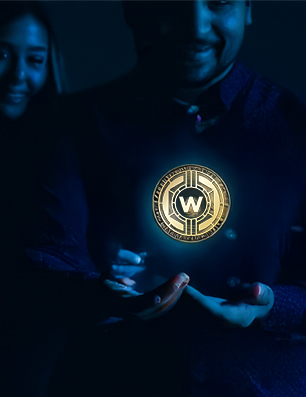- Written by: Nazar Kuzmyn
- Sun, 28 Aug 2022
- United States
As the field is quite young yet, there still exists a lot of confusion among the notions. Continue reading Crypto Gaming, Play-to-Earn, Metaverse, Blockchain Gaming, GameFi, And NFT Games: What Are The Differences? at DailyCoin.com.
Crypto Gaming, Play-to-Earn, Metaverse, Blockchain Gaming, GameFi, And NFT Games: What Are The Differences?
Video games as a form of entertainment have existed for more than half a century already. The first commercially successful arcade machine, Pong, is celebrating 50 years this year.
Compared to this, crypto gaming is a brand-new field. It started in 2021, with a chain of events: the NFT boom, Axie Infinity’s popularity, the rise of blockchain games, Zuckerberg announcing Meta, and the metaverse boom.
As the field is young yet, there is still a lot of confusion. And one area of differentiation comes with understanding the following: Play-to-Earn, blockchain games, GameFi, NFT games, metaverse, Web3, and Web 3.0.
The “Chicken or the Egg” Dilemma: What Are NFT Games?
According to some sources, including Wikipedia, the first widely known crypto game was CryptoKitties. Its main purpose was to collect NFT cats and breed them in order to get more and more unique and rare species. I know, it’s not enough gameplay to be exciting, especially knowing good examples of the collecting Tamagotchi-like games, such as Neko Atsume.
However, the purpose of the first NFT games, including CryptoKitties, was to utilize blockchain technology in the gaming field. It was the first game where you could own your characters as NFTs and transfer them to other platforms, such as marketplaces. Pioneers aren’t perfect though.
Moreover, the idea of the Ethereum blockchain, the one NFT games were built on at the beginning, was created by Vitalik Buterin after he lost his character’s equipment after an update in World of Warcraft. He understood that digital items earned with “sweat and blood” could be easily taken from you by developers if the project is highly centralized.
Thus, non-fungible token (NFT) technology, which provides “true” ownership, seems to be the most suitable for the gaming field. CryptoKitties were solely focused on collecting and creating new NFTs. Moreover, the game’s logic was fully based on blockchain technology.
Therefore, an NFT game is usually an idle game with the purpose of collecting NFTs.
Play-to-Earn Is Not Always About Crypto
In contrast to the first NFT games, Axie Infinity took a step aside from being built solely on blockchain. Yes, its gameplay was similar to NFT games at the beginning. However, the game’s logic wasn’t fully on blockchain anymore.
Moreover, with the introduction of an internal crypto-economy, the game expanded its earning mechanics; now the way to earn profits isn’t only by breeding Axies and selling them on a marketplace, but grinding internal currencies, Smooth Love Potion (SLP) and Axie Infinity Shards (AXS), and exchanging them into stablecoins inside the internal decentralized exchange, Katana.
At this point, Axie Infinity became a “true” play-to-earn game. So we reached the point where it’s very important to mention one thing.
Play-to-earn is just a monetization model, not a game genre.
Many MMORPGs utilized fiat-based auctions or secondary markets, prior to crypto game existence. Technically, those were pure play-to-earn. However, the marketers of crypto gaming projects overused the term, so it became associated with blockchain only.
In some cases, it obtained even negative connotations. For example, Steam banned all games that utilized cryptocurrencies, not even differentiating games fully built on a blockchain or using crypto as an addition to other game mechanics.
The term “play-to-earn” came from the names of other monetization models: free-to-play and pay-to-play. In its turn, Play-to-Earn spawned its variations, such as Move-to-Earn, Sex-to-Earn, Learn-to-Earn, and so on.
Crypto Gaming vs Blockchain Gaming: What’s the Main Difference?
Without a doubt, crypto gaming and blockchain gaming seem like the broadest notions to characterize industry in general as well as a single game project as its unit. Moreover, sometimes people tend to use those as synonyms, which makes sense in some cases but not everywhere.
“Non-Fungible” differentiates these two terms based on the level of their decentralization. For example, Decentraland is a blockchain game because it functions as a DAO and allows a high level of creativity, to the extent of the creation of games inside the game. In contrast, Light Nite X only provides rewards in satoshis, being a centralized project itself.
However, this approach is not as accurate when it comes to games having something from both sides. For example, the Axie Infinity ecosystem includes Ronin (RON) solely as a governance token. However, what about Bomb Crypto, which utilizes its native token Bombcrypto (BCOIN) as both in-game currency and a governance token?
When we come to such complicated ecosystems as Gala, which operates on both Gala governance nodes and Gala (GALA) cryptocurrency but works as a game development studio as well as a game publisher for smaller studios under their wing, its definition is unclear.
Considering the complicated nature of the field, let’s have a rule of thumb: “crypto gaming” is the broadest notion. It does include blockchain games, NFT games, and all Play-to-Earn with integrated crypto. As for “blockchain gaming,” it’s still a wide notion, but excludes fully centralized projects with small implications of crypto and NFTs.
For example, if Ubisoft ever integrated the released NFTs into Ghost Recon: Breakpoint, it would become a crypto game but not a blockchain game. However, there’s a dilemma whether to call a game “a blockchain game” if the game’s logic stays solely on blockchain.
In my opinion, this doesn’t work anymore. It did become a synonym for crypto gaming: both DappRadar and Wikipedia consider those as interchangeable notions. Moreover, the number of games built only on blockchain is falling.
What About GameFi?
Obviously, the term “GameFi” is derived from “DeFi,” which means “decentralized finance.” At first, GameFi was called “DeFi-based games.” After some time, GameFi became a popular keyword in South-Eastern Asian countries. A common trait of such GameFi projects was a team page with cartoon characters instead of real people. Thus, the term had some negative connotations and didn’t find wide popularity outside the area, according to Google Trends.
In general, GameFi combines three notions: DeFi, NFTs, and blockchain-built games. Therefore, it can be used as a synonym for blockchain gaming. However, as I mentioned, it did not stick with American and European audiences.
Furthermore, a Web3 company named “GameFi” adds more fuel to the fire of confusion.
Let’s Shed Some Light on the Metaverse Dilemma: Web3 or Web 3.0?
Although some people consider “Web3” and “Web 3.0” interchangeable, they are slightly different things. Web 3.0 is a concept of the Semantic Web, provided by Tim Berners-Lee back in 2006. This is the next step in the evolution of internet development where machines understand meanings, therefore semantics, rather than the structure of data.
On the other hand, Web3 is a newer concept provided by Gavin Wood, Ethereum co-founder and creator of Polkadot. Web3 is one of the possible ways of Web 3.0 evolution, based on the concepts of decentralization and increased data security.
As for the term “metaverse,” it’s too wide to be associated only with crypto. In fact, this is one of the internet iterations including the usage of mixed reality: augmented reality and virtual reality. The concept was widely used in science fiction, and only in the last few years, became associated with blockchain and decentralization.
To Sum Up
- A crypto game is any game that includes crypto in any form: an in-game cryptocurrency or NFT technology. It can be either centralized or decentralized.
- A blockchain game is a crypto game that includes some sort of decentralization: nodes, governance tokens, etc.
- GameFi is a synonym for blockchain gaming, which is widely used only in South-Eastern Asian countries.
- Play-to-earn is just a monetization model. It became associated with crypto gaming only in the last few years.
- An NFT game is usually an idle game with its main gameplay focus on collecting NFTs. In most cases, the game’s logic is built on blockchain.
- Web 3.0 is a concept of the Semantic Web, provided by Tim Berners-Lee back in the 90s.
- Web3 is one of the possible ways of Web 3.0 evolution, based on the concepts of decentralization. It was coined by Gavin Wood in 2014.
- The metaverse is one of the internet iterations focused on AR and VR. What used to be called a metaverse in crypto media is a decentralized metaverse.
In the end, I would like to mention that there is no standardized terminology yet. Thus, different sources may use these terms interchangeably. However, based on semantic derivation, this seems to be the closest differentiation to the right one.






